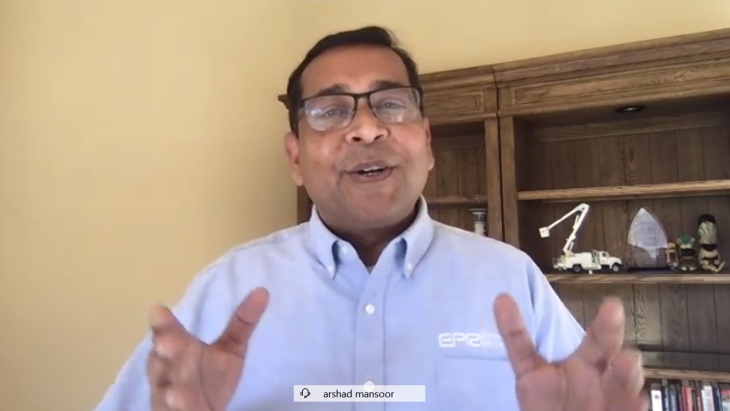Carbon emissions may be falling but the clean energy transition journey is far from over, Edison Electric Institute (EEI) President Tom Kuhn said. EEI's members - US investor-owned electric companies - have committed to emissions reductions of up to 50% by 2030 and 80% by 2050, and those reductions need to be achieved while ensuring electricity supply is both reliable and affordable, he said.
"It really is going to take a combination of all those technologies out there to make that happen," he said. "Zero-carbon technologies - like solar, and nuclear, and wind. Storage and energy efficiency. The combination of all those things is going to help us to get there."
Natural gas will continue to be needed on that journey, but new technologies including carbon capture and storage, and new nuclear plants, will be necessary to reach "that last 20%", he said. Bipartisan action will be needed to make clean energy legislation happen, and EEI is "very pleased" that the Biden Administration has decided to rejoin the Paris Agreement, he added.
Bipartisan support for US nuclear
Nuclear accounts for one-fifth of all electricity generated in the USA and half of its carbon-free production, as well as being the largest source of carbon-free power "anywhere on Earth", said Maria Korsnick, president and CEO of the Nuclear Energy Institute (NEI).
Nuclear innovation is happening around the country, she said, citing the Vogtle construction project in Georgia which are expected to come online later this year, and demonstration projects that are now under way. "These will make nuclear even more efficient, versatile and affordable," she said.
The "unique reliability" of nuclear among all carbon-free energy sources has become even more apparent over the past year, she said. "Our industry's workers have kept the lights on at hospitals and in homes during this global pandemic."
Nuclear energy and the workers that make it possible have been "essential" for resiliency in response to the current challenges. "Because of nuclear energy's attributes, nuclear enjoys well-earned bipartisan support. Policymakers on both sides of the aisle value the carbon-free electricity that nuclear generates and the economic growth that it provides," she said.
Korsnick highlighted Department of Energy awards to enable companies to build demonstrations of their advanced reactor technologies; Department of Defense moving forward with plans for its own micro-reactor; and agreements to streamline the licensing of new technologies. Within the industry, innovative companies are investing in advanced nuclear technologies that will offer more affordability and versatility, she said.
"The next four years will be critical for the nuclear industry and our ability to meet our climate goals. But to build a carbon-free energy system, we first need to preserve our existing carbon-free sources," she said. Eight US reactors - units that together generate over 60 million megawatt-hours of carbon-free electricity - are this year under threat of closure.
"We simply cannot afford to go backwards. A national commitment to 'building back better' must include building the clean energy grid of the future. That starts with states protecting the largest source of zero-emissions energy that they’ve got - and the high-skilled, good-paying jobs that nuclear provides."
Moonshot
Electric Power Research Institute (EPRI) President and CEO Arshad Mansoor said all sides of the US energy industry must come together immediately to speed the pace of decarbonisation across the economy. The electric sector has become 33% cleaner over the past 15 years, but the economy's removal of carbon emissions has progressed much more slowly during the same period. "If we have the same path of acceleration, it's going to take 75 years [to achieve the desired carbon removals]. Clearly, we want to accelerate," he said.
The continued decarbonisation of the electricity sector is fundamental to decarbonising other sectors of the economy, like transportation, Mansoor said, but the challenge is to achieve that decarbonisation while maintaining an electricity supply that is affordable to an average household. "It's not going to be easy. We need to make sure that the largest carbon-free source of energy - nuclear - still stays online," he said.
We are "at the cusp" of widespread electrification of transportation but for a future where six out of every 10 cars are electric by 2030, and 30-40% of energy is provided by renewables, "we have to reimagine the grid" to ensure it is ready and resilient to support that.
Electrification is not a viable decarbonisation solution for so-called "hard to abate" sectors of the economy, including such industries as cement, steel and chemicals manufacturing, maritime shipping, and aviation, Mansoor said, noting that before the current decade is over, the energy industry must be able to offer "other sets of molecules", such as hydrogen, liquid ammonia and synthetic fuels as clean energy carriers.
The Low-Carbon Resources Initiative was launched last year by EPRI in partnership with the US Gas Technology Institute to leverage a combination of resources in all areas of the energy industry to accelerate the development and deployment of technologies to enable this to happen.
"A high-temperature advanced nuclear reactor could actually produce hydrogen in a cheaper way when [its] electricity is not needed because we have plentiful wind and sun," he said. "The opportunity to produce hydrogen in a better way - a more affordable way - and keep all of our options open, that is one of the modes of innovation that LCRI is studying", he said.
"It's a moonshot," he said. "This is the decade we'll have to make a commitment. Before this decade is over we have to have other sets of molecules - clean energy carriers. … We look to a future where we have multiple options to get to net zero. But let's make sure we do it in a reliable and affordable way."





_47120.jpg)

_23621.jpg)






